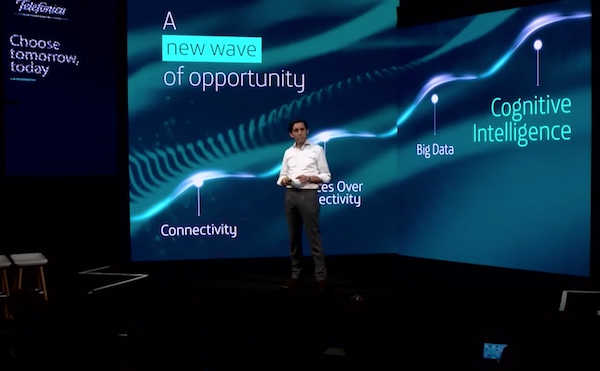Telefonica Launches Aura Voice Assistant and Partners with Microsoft, Google and Facebook
Telefónica last year demonstrated the Aura voice assistant and today it officially launched in Argentina, Brazil, Chile, Germany, Spain and the UK (the full presentation from Mobile World Congress and be viewed through the above video). Aura doesn’t have all the capabilities of Microsoft Cortana, Facebook Messenger or Google Assistant, but instead integrates with those services to provide users with more features. For example, a Telefónica executive demonstrated how you can type “Let’s talk to Aura,” from within the Google Assistant app to access the voice assistant. Facebook made a similar announcement that you can access Aura through Messenger although that feature is limited to Chile and Germany today. The most expansive integration appears to be with Microsoft. Telefónica used Microsoft’s Bot Framework and relies on LUIS technology for natural language understanding.
A Vertical Voice Assistant Offers Depth and Control
Telefónica claims to have become a platform of platforms for AI services. The company talks about this as a fourth platform focused on AI, data and integration of third-party services. Scott Huffman, VP of Google Assistant engineering joined in Telefónica’s announcement at Mobile World Congress to demonstrate the Aura integration and reveal that it is one of the first to join the Google Assistant Carrier Program. Telefonica also commented that “Aura needed to be on one of the biggest platforms on earth which is Windows.” Gupreet Singh Pall from Microsoft discussed both the AI integration and the intent to add Cortana connectivity in the future.
What we are seeing is that general voice assistants from Microsoft and Google have access to broad sets of information, services and technology that other companies can simply adopt instead of building on their own. These companies can then add capabilities specific to their vertical or service to enhance the customer experience. That may involve introducing a new voice assistant like Aura to manage part or all of the user engagement. By having their own voice assistant front end, these companies maintain user experience control and have unfettered access to user data while using the solution.
Multi-modal from the Start
Aura integration with chat apps is part of Telefónica’s strategy to be available where their customers are interacting with technology today. If you are in Chile and want to check your phone charges or data usage, you can do that through Aura directly or Facebook Messenger. You can do this through Google Assistant on Android phones as well. In addition, Aura has also been extended to support home entertainment and smart home use cases for its pay-TV customers in Spain. Light Reading reports:
“In Spain, where Telefónica provides pay-TV services to about 3.5 million customers, the operator has gone a step further, including the Aura technology in a ‘Movistar+ Habla’ app that allows customers to control TV and other services. The operator’s Spanish business will also this fall introduce an Aura-powered home hub branded Movistar Home that lets customers make and transfer phone calls between devices and activate a range of smart home services.”
Focusing on Vertical Features
The Movistar service introduces a much broader set of capabilities and suggests Telefónica’s ambitions don’t end at providing access to user account information. It could be that Google Assistant simply fills a gap for Telefónica today and that more of those services will be subsumed into Aura over time. Regardless, the option to specialize Aura around vertical features and utilize Microsoft and Google for their technology and ability to deliver other features looks like a model we are likely to see repeated. This architecture may also foreshadow what we will see from Orange’s Djingo voice assistant later in 2018.
Does this move also suggest we should expect voice assistants from Verizon, AT&T, T-Mobile and Sprint in the U.S.? That is unclear. U.S. telecom carriers don’t seem to be focused on voice and AI as much as Telefónica, Orange and Deutsche Telekom. However, at some point the value of these enhanced services will become clear to the carriers as another method to retain customers. Telefónica’s announcement can rightly be highlighted as important because it will bring voice assistant technology to millions of South American consumers for the first time. However, it may be even more instructive on what it says about the future of user features for telecom services.
Google Assistant Coming to 30 Languages and Adding Multi-lingual Support in 2018
Okay Djingo, Let’s Beat Amazon Alexa to France Says Orange. Will it Work?









